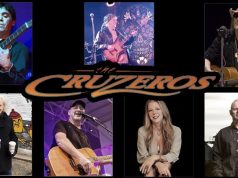Talking Heads Q&A: ‘Stop Making Sense’ Returns to Theaters
By Fred Topel

Moviegoers everywhere can experience Stop Making Sense on the worlds’ biggest screens on Sept. 29. But, the night of the premiere, the Q&A with David Byrne, Jerry Harrison, Chris France and Tina Weymouth was simulcast around the world. Spike Lee asked the questions, and here’s what the Talking Heads had to say looking back on Stop Making Sense.
SL: Let’s go back to the origin. Spider-Man #1, Daredevil #1, the origin.
DB: This was more or less our tour. This was more or less what we were doing on tour. There were a few songs that were cut out. The intermission, the encore gap was cut out but other than that, this is kind of the show we were doing. It seemed like it had a kind of progression to it, a story. I think it occurred to us, this could maybe work as a film. It’s got a beginning, a middle and an end. We started thinking about who could direct this? How could we do this and how do we pay for it?
SL: And then the late great Jonathan Damme. The great director Jonathan Damme.
CF: I miss Jonathan. He would’ve been so happy to see this tonight and to hear it. Jerry, you did a good job.
JH: Thank you.
CF: And I miss Bernie too. The great Bernie Worrell.
SL: Sitting here watching this in this IMAX theater. You shot this, four performances, Pantages theater in LA, it came out 1984. How is it coming back to see this after decades? Remastered, remixed, IMAX, all of that.
JH: I would say that one of the wonderful things is the fact that there is new technology meant we almost have a burden to adapt and to bring it up to what people can hear now in theater. One of the things I noticed is that with the multi-channel audio. If you wanted to listen to Bernie, I can hear the whole mix but over there I can hear it. I only heard Alex over there in a way that you couldn’t in ’84 and even in ’99. So it’s a delight to see that we found the original negatives and therefore we could bring it back to life as much as possible and make this sound appropriate to the theaters like the one that you just got to listen to it in.
DB: When I was watching this just now, I was thinking this is why we come to the movie theaters. This is different than watching it on my laptop. This is really different.
SL: I’m a cinefile. This is the greatest concert film ever. And I can say that. You might want to, but for me, I’m going on record. I went on record, around the world. This is the greatest concert film ever. No one’s gonna cosign that?
CF: Talking Heads was such a good band and when we had that expanded lineup, excuse me for blowing my own horn, our own horn, it’s so good to be here with my bandmates tonight. With the expanded lineup, with Steve Scales and Bernie Worrell and Lynn Mary and Edna Holt and Alex Weir, they just took us into a whole nother dimension. I’m very grateful to be here tonight and to be able to watch this and to enjoy it so much.

CF: Sure. Jonathan came to see the show. He came backstage and said, “I would love to make a movie.” I think that’s how it happened, right? It was as simple as that. We had been admirers of his work. Caged Heat anybody? But the real thing I think that hooked us on Jonathan was the movie Melvin and Howard which was a very different kind of movie, wasn’t it? In its time, beautiful movie.
SL: How many cameras did you have each night?
DB: It was four each night, four or five so it was at least a dozen once you got ‘em all synced up together. Six a night? That’s 18 all together.
JH: The one thing I also think was unique about this is we shot this at the end of December, then went to Australia and New Zealand to play some shows, came back and it came out in April. It was like a sprint and nobody ever got tired. We sprinted and it’s like we finished. So many projects are interrupted with like you’ve got to take a break. We never took a break and it kind of feels that way. It just feels like it just flowed and it was finished.
SL: I want to go down the line. Start with the bassist, your favorite performance, song of what we just saw.
TW: Come on, Spike. That’s like making me choose which of my children. I’m not going to go there. I love that show. It was magical. Everything about it was so special and with the love that you talk about with us and the audience, the teamwork, our crew, the film crew, it was all amazing. And we had Sandy McLeod, she toured with us. What did they call her? What’s her credit? Visual consultant? That’s a weird one. Okay, I guess you have to give her a name.
TW: Sandy McLeod was actually with us on tour and she mapped out every shot ahead of time. She took notes on every song, what each player was doing, who was moving, who was where. I think that really helped the team when it came time to shoot.
SL: How many times did Jonathan Damme see the show before you?
DB: A lot. He came on tour too.
CF: He wasn’t there as much as Sandy McLeod because Jonathan, it’s no secret, Jonathan was making this movie with Goldie Hawn at the same time. It was supposed to be a warts and all kind of movie. That’s what the star of the movie wanted. Then she saw the dailies and she said oh no, I don’t like warts and all. They had to go back and reshoot a good deal of the movie to make the star happy. So Jonathan wasn’t expecting to have to reshoot half that movie but he had to so he didn’t get to come out on tour I think as much as he would have liked to. But he certainly dug the band and understood what we were about and helped us to celebrate. Celebrate the music because when you get right down to it, the music is greater than the band even. We might be dead but the music continues.
SL: Live forever! You got a song? Favorite? I know I’m putting everybody on the spot, but…
CF: I’m going to say “Once In a Lifetime” because it’s like going to church and it’s very moving to me. It’s got a power that many other bands and songs never achieve.
JH: I’m between two. I would say “Life During Wartime” which I think is sort of a moment. It’s like where the movie sort of takes off. If you haven’t been dancing, you’ve got to get up and start dancing. And I’m a big fan of “Girlfriend is Better.” If the music is this weird abstract thing that is going on. It’s like you listen to these parts, so it has this kind of, I don’t know, anyway, unusual modern music to it. Every time I hear it I thought God, do I love that song. So I want to call that one out.
DB: I agree with all what they said. “Once in a Lifetime” is amazing because it’s almost one shot. Not the whole thing but almost. It’s Jonathan’s decision. It plays so why cut away until we have to? Some of the others,

DB: Oh, the origin of that was it was in between tours and I was thinking what are we going to do next? Maybe I should rethink what we wear on stage. I was having dinner in Japan after we finished a tour and this designer said, “Well, David, in the theater, everything is bigger than real life.” He was referring to gestures and you sing louder and all that. I’m thinking oh, my suit should be bigger too.
JH: The one thing I can say about the suit is that there were two of them that were made as I remember. Actually, the one that you used was a friend of mine who made it because the second one had sort of plastic, was lighter but it didn’t move with your body the same.
DB: Yeah, picture all that shaky stuff.
JH: This one reacted with you.
SL: So from West Melbourne, why do you think Talking Heads still remains so relevant today? What makes your music timeless?
TW: I’m sorry to say it’s not really blues based. Blues is so great, jazz is so great but maybe we kind of mixed it up a little and went in a different direction because there were already great blues players out there. So we didn’t do that.
JH: Having been the one person who had been in another band and joined the band, the Talking Heads music felt new and of its own piece. Yes, there were influences. Obviously R&B was an influence but when I joined the band, I went there’s nothing going on like this. I don’t know how big an audience we’re going to get but I know that we are going to be treading new ground. I think we did and that’s why it’s timeless.

JH: Well, one thing is for this is we recorded it digitally so that it was the beginning. We were the pioneers of doing this and that was because we knew that in the process of making a film, you must re-record at various times and we didn’t want to have generations going down. Then I also have to say the mixers and the people we worked with, but also when we did the original mix, David and I were there. I was involved with Gary Goetzman and various other engineers and making sure that we retained that quality.
SL: From Montreal, while you were in production with Jonathan Damme, which film inspired you for the visual aspect of the movie?
DB: There wasn’t a lot in Jonathan’s movies visually that compared to this. It was more like he was aware of how people related to one another and he brought that to a concert movie. You don’t see it in every kind of concert movie. I remember when we were thinking about this, I look at whatever concert movies and things I could at the time. I remember looking at a Neil Young one called Russ Never Sleeps where he had giant amps and I thought hey, that’s pretty good. There was the P-Funk tours with the mothership coming down. There were these very theatrical shows out there that still had a lot of credibility and I thought okay, there’s a way to do this.







